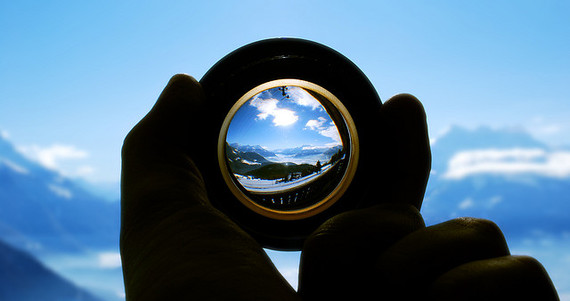
Photo credit: Philippe Henry
What changes -- and what becomes possible -- when we see our organizations through a living systems lens?
That question has been at the heart of my work for the past fifteen years. Things have come a long way in that time. From a dominant paradigm that saw organizations as mere machines, it's become clear to most that there is more to the story. For example, where workers and customers were considered external to the machine, it is now more broadly accepted that they are integral to the organizational ecosystem. And while previously the single goal of business was profitability, today many are embracing the imperative to contribute explicitly to life's ability to thrive.
Still, as much as we've made great progress, not every organization gets equal benefit from this emergent understanding. Most achieve modest improvements to their culture and operations, leaving plenty of opportunity on the table. But a small number cultivate something vibrantly generative -- and even regenerative -- creating unimagined benefits for people working within the organization, for customers and community, and for the biosphere.
So, what makes the difference between generic and generative?
Certainly, there must be many factors at play. But here's one thing I've noticed: if the living systems lens were actually a pair of glasses, it would be trifocals, offering three distinct views. And what you do with it -- what that perspective changes and makes possible -- depends on which of the three parts of the lens you look through.
The first of these lenses is instrumental and tactical -- the lens of the hands. Focused on matters closest at hand, it reveals training options, best practices and tactical adjustments. As my colleague Michael Jones says, it poses the question, "How can we do things differently?" In my own client work, this has included interviewing employees and customers (now that their voice clearly matters), changing a company name and logo (to convey the genuine care that was really there), and improving retail décor (to make it not only functional but nourishing to living people). Actions guided by this lens bring useful results. But without the other lenses, the impact is incremental at best.
The second lens is intellectual -- the lens of the head. With a slightly broader view, it suggests new vocabulary (network, ecosystem, self-organization, emergence), and it reveals new strategies, asking, "How can we do different things?" Here, my work has included introducing the practices and mindsets of applied improvisation (to embrace and support emergence and collective intelligence) and reshaping governance structures (to engage more of the ecosystem in decision-making and to align with life's organizing patterns). Actions guided by this lens have a more dramatic impact. But they still don't fundamentally shift the nature of the organization from generic to generative.
Only the third lens -- the lens of the heart -- is fully transformative. The question becomes, "How can we see differently?" And here, we discover the most far-reaching -- and profound - implications of the living systems lens, as we truly begin to perceive the aliveness in our organizations, our communities and ourselves. Here, we see the purpose of the organization with fresh eyes: we come together in organization to create ever more thriving, transforming and being transformed through interaction, contribution and learning. Curiosity and fascination become the most appropriate sentiments, alongside reverence and responsibility for the marvel of life. We see our role less as manager and mechanic and more as steward and gardener, carefully designing interactions and infrastructures to support thriving and emergence. We notice that we -- and our organizations -- are deeply rooted in and nourished by stories of place and belonging. And we embrace the ongoing practice of aligning with life, deepening into compassion and wisdom, with trust that this is the most direct path to greater effectiveness.
All three lenses are needed. And the most powerful possibilities come into view only when all three are used together, with the expansive lens of the heart leading the way.
What does that look like in practice? Here's what I've seen:
- It looks like a young woman declaring at a stewards meeting that she now realizes she doesn't "work for" the company; she is "part of" it, and that this realization has given her a much stronger sense of engagement and responsibility.
How can your organization get to this level of engagement, innovation and impact? In other words, how do you draw on all three facets of the living systems lens?
The honest answer is: it takes intention, openness, conversation and time. But it can start with a simple question:
What would it look like if this interaction or this aspect of our infrastructure (this agreement, this physical space, this process) contributed to vibrant aliveness, connection -- and even healing -- for every life it touches?
As this Great Work Cultures blog series explores ways to "create a culture of respect and empowerment in our workplaces," it may be helpful to remember that "culture" is a biological term, acknowledging the presence of life and inviting us to cultivate it with intention, care and wonder at the rich potential inherent in any living system.
Michelle Holliday is a facilitator, organizational consultant, researcher and writer. Her work centers around "thrivability" -- a set of perspectives, intentions and practices based on a view of organizations as living systems. Through her company, Cambium Consulting, she brings people together and helps them discover ways they can feel more alive, connect more meaningfully with each other, and serve life more powerfully through their work. This generally takes the form of accompanying organizations through change, designing and hosting transformative events, as well as delivering talks and workshops. Michelle also writes regularly, including a forthcoming book, The Age of Thrivability: Perspectives and Practices for a Thriving World. Her research is summarized in a slideshow called Humanity 4.0, as well as in a TEDx presentation. She is the co-founder of the Thrivable World Quest.
